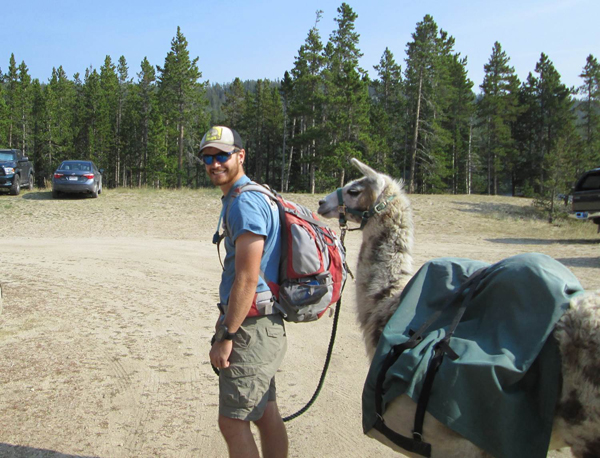by Richard Adams1 and Connor Johnen2
In the summers of 1969 and 1970, two Colorado State University students (Vaughn Hadenfeldt and Phillip Foss, Jr.) prospected for high altitude archaeological sites in Wyoming’s Wind River Range. They recorded 19 prehistoric high altitude sites and wrote a 100 page term paper on the project in 1971 for the late Anthropology Professor Liz Morris. Apparently, Professor Morris passed their paper on to Dr. James Benedict—the world’s preeminent high altitude archaeologist. After Dr. Benedict died in 2011, CSU Anthropology Professor Dr. Jason LaBelle found the term paper while going through Dr. Benedict’s extensive library of alpine research and handed it to CSU Anthropology adjunct Richard Adams who has worked in the Wind River Range for several years. There was not enough information in the 1971 student paper to complete formal site forms, so in 2015, Connor Johnen (CSU BA, Anthropology, 2014) and Adams applied for grants to cover the cost of backcountry archaeology. Over the course of seven days, a team of six archaeologists relocated and recorded sites from 1969 as well as located several undiscovered prehistoric archaeological sites. This project goes a long way toward completing Wyoming’s first high altitude archaeological survey.
Background
In 2011, Colorado State University Anthropology Professor Jason LaBelle found a student paper written in 1971 for Dr. Elizabeth Morris, an Anthropology Professor at CSU, in the late Dr. James Benedict’s library.
The report was written by two of Morris’ undergraduates, Vaughn Hadenfeldt and Phillip Foss, Jr. In the summers of 1969 and 1970, Hadenfeldt and Foss explored two drainages in the southern Wind River Range, in Wyoming. They recorded at least 19 prehistoric sites (most above 10,000 feet asl). They submitted the survey results to Morris in 1971. No site forms were ever filled out.
Professor LaBelle suggested that CSU Anthropology adjunct Richard Adams pursue the project given his previous work there. Site numbers were obtained in 2012, but there was not enough information in the student’s paper to complete site forms for these sites.

Aspiring backcountry archaeologist Connor Johnen, who got his BA in Anthropology from CSU in 2014 and is now a graduate student at the University of Wyoming, applied for, and receieved, grants from the George C. Frison Institute, the Wyoming Archaeological Society, and the Loveland Archaeological Society.
Late Summer Fieldwork with Llamas
From August 21 to 27, 2015, a six-member team of professional archaeologists, anthropology students, and a National Outdoor Leadership School instructor hiked into the high country of the southern Wind River Range accompanied by six llamas rented from Lander Llamas. Our goal was to relocate 15 of the 19 sites reported by Hadenfeldt and Foss in 1971 (the remaining four sites are in a different drainage basin).
The team was led by Dr. Adams and Connor Johnen; accompanying them were William Restrepo (CSU BA, 2014, ** and Anthropology), and current CSU Anthropology students Andrew Richards and Brady Nelson. All four current and former CSU students had taken the CSU Field Archaeology Field School (ANTH 260/460) and were no strangers to high altitude archaeology. Along with the CSU team was Casey Pikla, the National Outdoor Leadership Schools’ (NOLS) Manager of Professional Training. NOLS is based in Lander, Wyoming at the base of the Wind River Range.
Preliminary Results
In seven days of fieldwork, the team walked about 80 miles and prospected diverse terrain ranging from 8500 to over 11,000 above sea level.
While they missed one of the 1969 sites, they relocated the remaining 14. In addition, they located and recorded 11 new sites. All of these are prehistoric camp sites or lithic scatters. They found artifacts spanning about 8000 years of prehistory. Johnen found the base of a soapstone bowl, a fairly rare artifact in the Rocky Mountains.
None of the archaeological sites is considered to be significant enough to warrant nomination to the National Register of Historic Places. However, experience has taught CSU archaeologists that truly spectacular sites are exposed after forest fires burns off the pine duff.
Artifact Analysis
As a result of efforts by Dr. LaBelle, Hadenfeldt and Foss donated the artifacts that they collected in 1969 and 1970. Johnen will analyze these artifacts as part of his Masters thesis research.
Preliminary Interpretations
On a week-long, llama supported trip into Wyoming’s Wind River backcountry, CSU Anthropology students and staff retraced the path of two pioneering high altitude archaeologists (and former CSU students) Vaughn Hadenfeldt and Phillip Foss, Jr. who discovered high altitude prehistoric archaeological sites in Wyoming’s Wind River Range in 1969 and 1970. By completing site forms, drawing site maps, and photographing the sites, this team of CSU staff, students, and alumni has taken a big step toward completing Wyoming’s first high altitude archaeological survey.
Connor Johnen presented his results at the 12th Biennial Rocky Mountain Archaeological Conference in Steamboat Springs, September 24-27, 2015.
1Anthropology Adjunct, Colorado State University, Richard.Adams@colostate.edu
2 Graduate Student, University of Wyoming and Alumnus, Colorado State University, CJohnen@uwyo.edu
